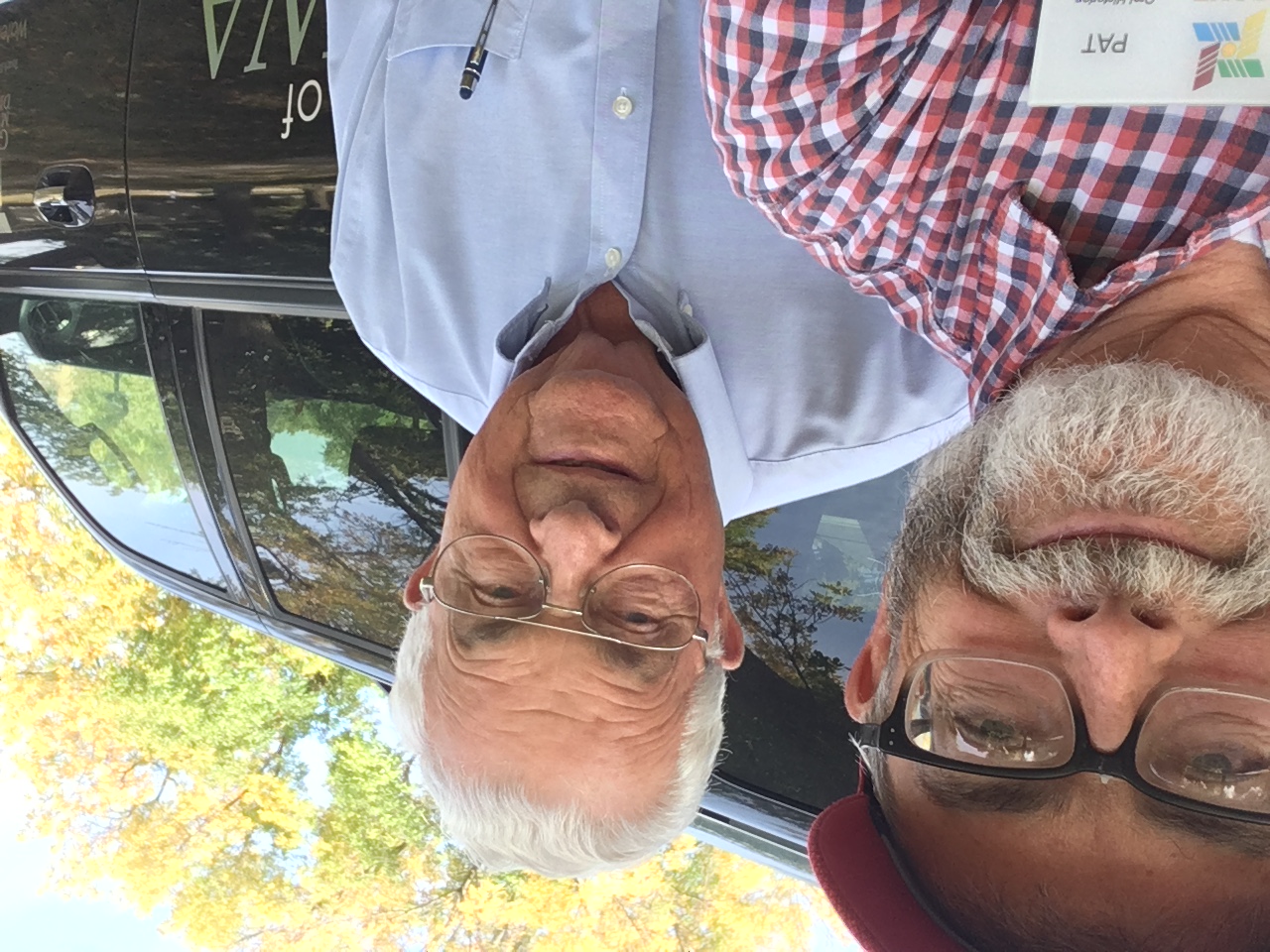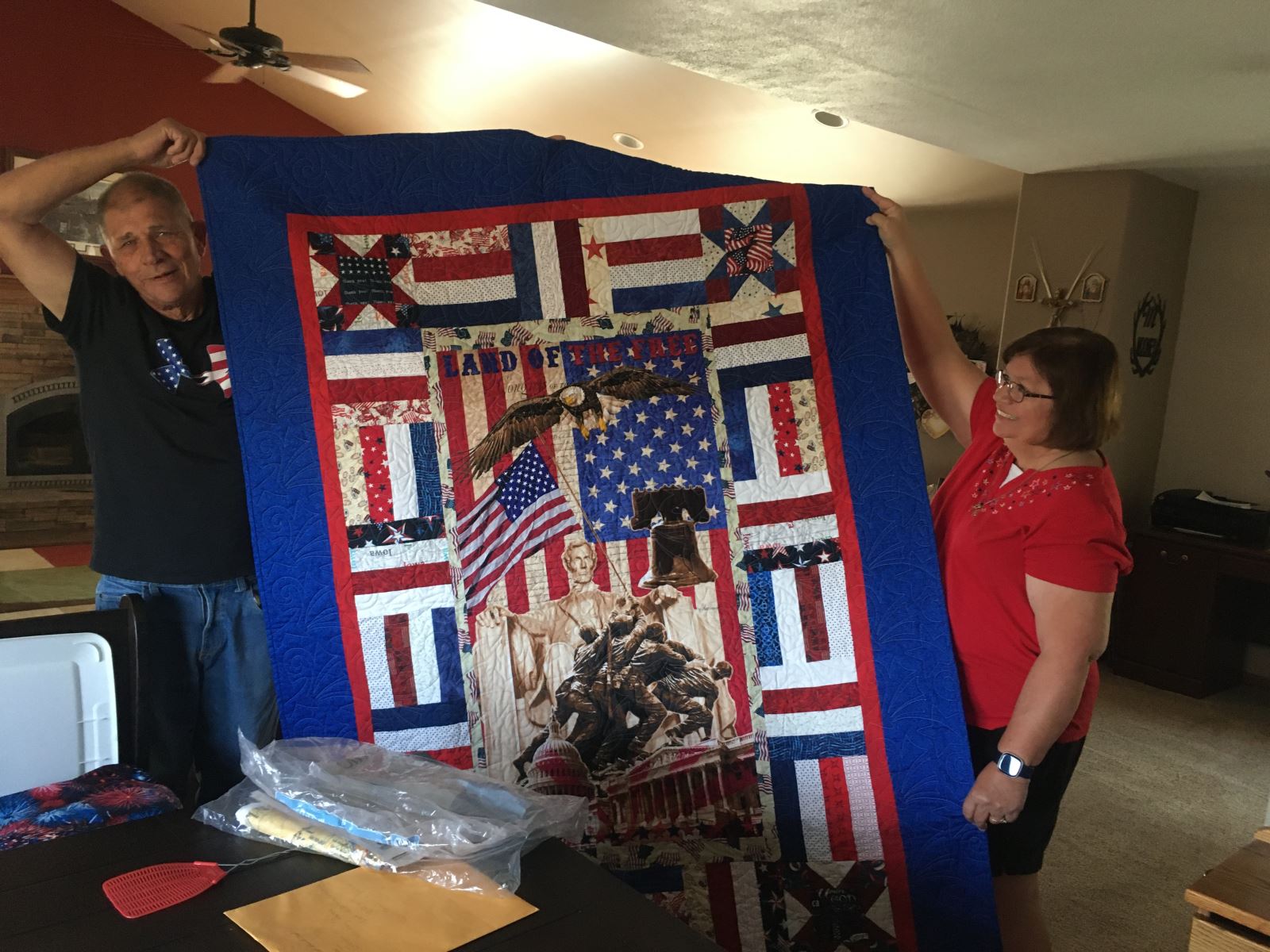Grout's 'Voices of Iowa' project goes 'on the road' to hear of veterans sacrifice.
Posted
by Pat Kinney
on Wednesday, October 12, 2022
SAC CITY -- Gordon Mooney went to war at age 49. It was 50 years after one of his teachers at Sac High School, Roland Harklau, did the same.

Korean War veteran Roland Harklau (center) of Sac City talked about his military experiences with Grout Museum District oral historian Pat Kinney on Kinney's recent trip to Sac City as part of the Grout's "Voices of Iowa" project.
Harklau taught history. Both he and Mooney became part of it, a half century apart.
Harklau was a U.S. Air Force crew chief in the Korean War, equipping and maintaining F-84 Thunderjet fighter bombers in numerous missions against North Korean and Communist Chinese ground targets on the Korean peninsula.
Mooney, after a combined 20 years' service in the U.S. Army and Reserves, was deployed to Iraq in 2003-04. He received a Purple Heart for wounds from a roadside bomb.
Both told their stories to the Grout Museum District, as part of the Grout's "Voices of Iowa" project on a recent trip to Sac City.
Harklau, a native of Somers, a community of about 1,100 in nearby Calhoun County, enlisted in the service at age 19 in December 1950, following the outbreak of hostilities in Korea.
After a couple of stateside duty assignments and traning in aircraft frame repair, he served a year in Korea, near Taegu, South Korea along what was known as the Pusan Perimeter, the invading North Koreans initial and deepest penetration of the war.
Although the area was firmly in South Korean and United Nations control by the time Harklau arrived in Korea, he nonetheless was very much involved in taking the fight to the enemy, loading explosive ordnance on the F-84s for missions all along what was known as the "Punchbowl" area along the 38th parallel between North and South Korea, where the war had settled into a bloody stalemate in the mountainous terrain.
Sometimes, pilots didn't return.
"When pilots first go up, they were afraid," he said. "Then they got cocky. Then when they got down close to 100 missions" when they no longer had to fly, "now they got to thinking about the odds of survival. And most of them that got shot down were in their later missions. We'd find out about it because of radio -- (enemy propagandist) Moscow Molly, or whatever her name was, would give the names of the pilots who'd been captured. And the Chinese and the North Koreans didn't treat our captives very well."
Sometimes the planes returned, damaged in battle and had to belly-land their aircraft, hoping the friction didn't result in them igniting in flames. And there were hazards for the ground crews in handling the bombs. And accidents. Harklau recalled one instance in which two ground crew men were blown up by a bomb they had prematurely armed before mounting it on a plane.
But for the most part, crews were as skilled in readying planes for the missions as the pilots were in carrying them out.
"In Korea, the guys I worked with were the very best of all my three years in the Air Force," he said.
Mooney, a half century later, felt the same way about his fellow Army Reservists, based in Cherokee. After having served four years active duty and 20 years in the Reserves, he withdrew his retirement letter when the unit was deployed to Iraq. Service had provided him direction in life. "I was lost. Now I was part of something," he said. Most of the unit was called up in March 2003; he was deployed the following November.
He ended up with the 443rd Heavy Equipment Transportation Company, driving a huge flatbed trailer that hauled the massive A-1 Abrams battle tank. He was stationed at Forward Operating Base Speicher, near Tikrit, Iraqi dictator Saddam Hussein's hometown. It was hazardous duty and they were subject to ambush and roadside bombs.
"I had an RPG rocket go across the top of my truck on my 49th birthday," he said, in an ambush on a night mission near Najaf. "It was, 'If I made it to 49, I want to make it home.' "
On Dec. 1, 2003, when his unit was hauling medical supplies from Mosul to Tikrit, his truck was hit by an explosion from a roadside bomb. "That was the first time that truck had rolled out of the gate with armor on it," he said. "We were 45 days from getting home. If that armor hadn't been on the truck, I wouldn't be sitting here today." Shrapnel punctured quarter inch thick armor and an auxiliary fuel tank as well as sun visors.
"There were holes in the cab of the truck, above us," he said, and percussion from the impact of the bomb knocked him across the cab of the truck "and knocked me out a bit," he said. His face was bloodied by debris and one eye was reddened by a hematoma. "I looked like I'd been dragged across a gravel road." His comrade in the cab had radioed for a medevac and had initially thought Mooney was dead.
"They medevaced us out," he said, but his comrades proceeded through the recovery after the damage "just like we practiced it."
"I called home. That was the worst phone call I ever made," he said, to tell his wife Margaret he had been hit. "It went like this: 'We had a little incident. We ran into an IED. I'm okay. The truck's dead. You're going to get a call from somebody. I was injured. Cuts and bruises. But I'm intact.' "
"I was very glad he called," Margaret said. She was just getting ready to leave for work. A call from an Army major came a few hours later. "That kind of made it real." She notified extended family.

Iraq war veteran Gordon Mooney, left and his wife Margaret of Sac City display the Quilt of Valor Gordon received for his service.
"The important thing is we all went, and we all came home," Mooney said of his Reserve comrades in Cherokee. "Some of us came home a little different. But we all came home. I'm pretty proud I'm a veteran."
And his old history teacher, Roland Harklau said, stories of service, like Gordon Mooney's and his own, are important to remember.

Iraq war veteran Gordon Mooney of Sac City received the Purple Heart for wounds in Iraq. He told of his experience to Grout Museum District oral hitorian Pat Kinney on Kinney's recent trip to Sac City.
The Sac County veterans Memorial, outside the Sac County courthouse in Sac City.
All Iowa veterans of all eras and branches of service are invited to tell their stories for posterity as part of the Grout Museum District's "Voices of Iowa" project. Veterans and their families will receive a complementary DVD of the interview. They will be in the museum district's permanent archives and used in exhibits. Those interested in being interviewed are invited to contact Pat Kinney at Pat.Kinney@gmdistrict.org. Bob Neymeyer at bob.neymeyer@gmdistrict.org or call (319) 234-6357. Interviews are conducted in the museum or on location.